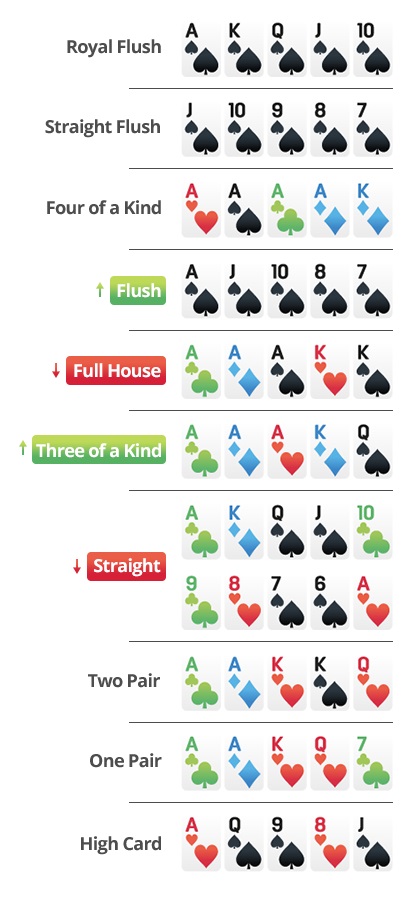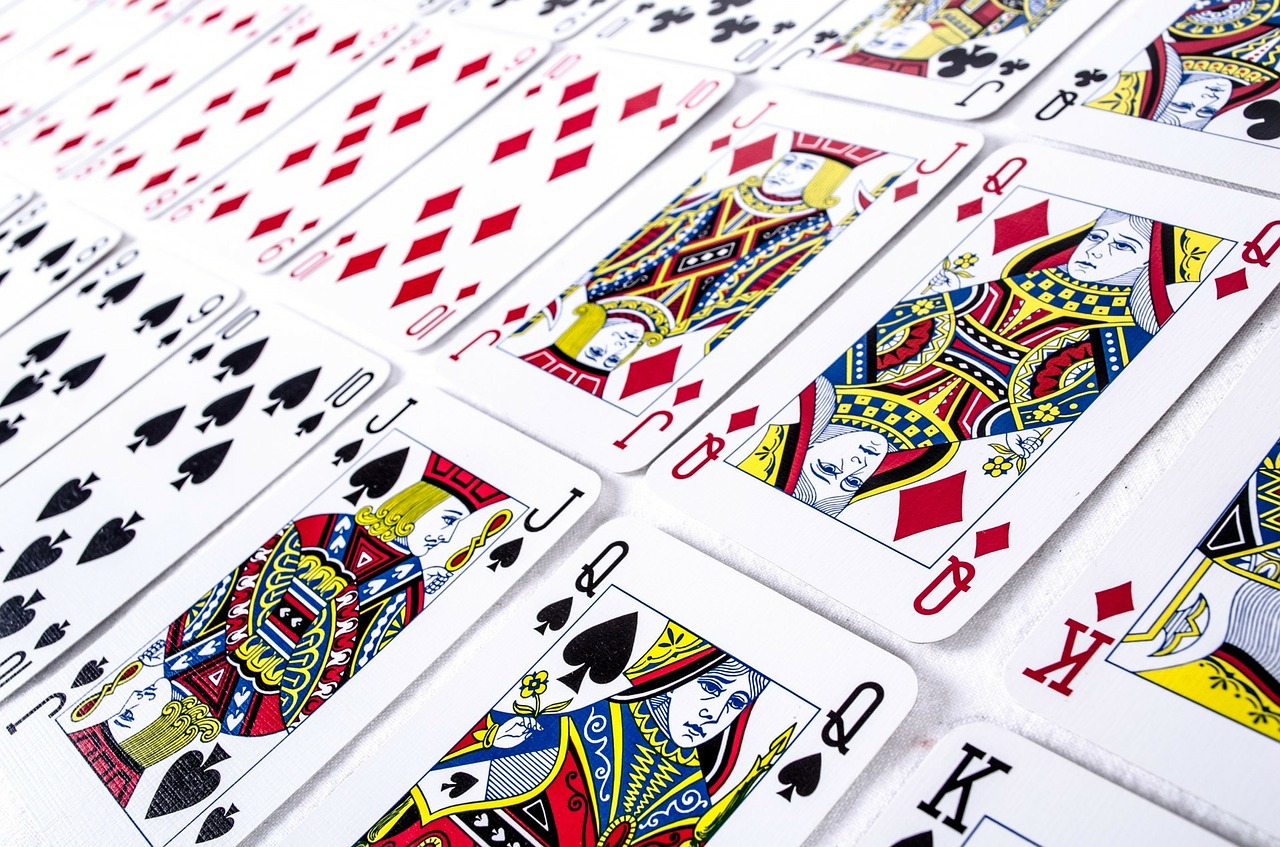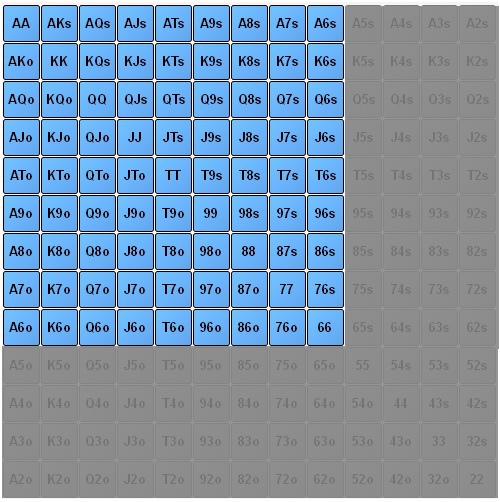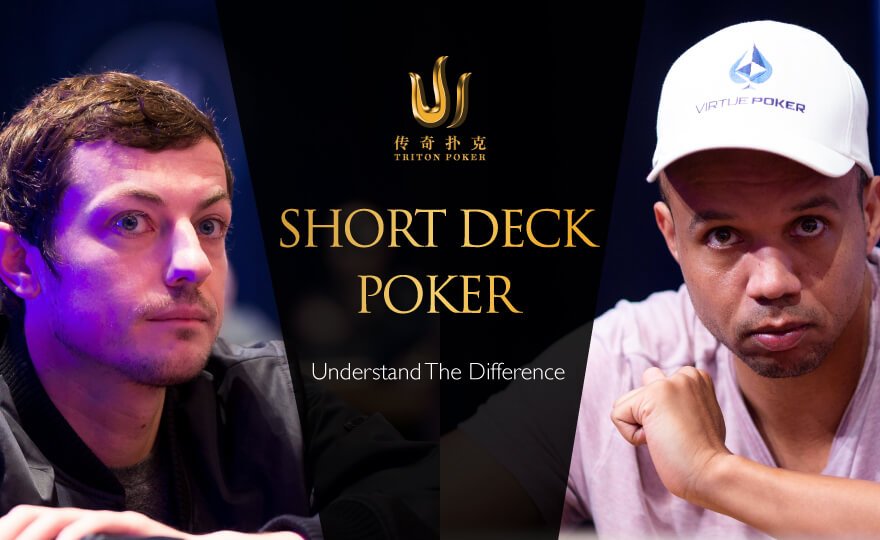Short Deck Poker Best Starting Hands
A pair of aces, also known as 'pocket rockets' (and sometimes 'American Airlines') is the best starting hand for Texas Hold 'em. Be wary of how many other players enter the pot, as more players increase the likelihood of someone beating your aces. Check out the short deck hand rankings. Martingale Europe Limited operates according to Maltese Law, and is regulated by the Malta Gaming Authority (MGA) under license MGA/CRP/688/2019 issued on 1/10/2020 in the name of the reporting entity bwin Holdings (Malta) Limited, located at Penthouse Spinola Business Centre, Number 46, St Christopher Street, Valletta, Malta, VLT 1464. Starting ranks and pot odds will be covered soon, but first up, learning the slightly different hand rankings is a must -if you don’t know what wins and loses you’re in big trouble! Because the game is only played with 36 cards instead of the traditional 52 (all the 2’s, 3’s, 4’s and 5’s are removed) there are a few differences to. Six Plus Hold’em/Short Deck Poker Beginners Strategy Now is the time to get up to speed and get ahead of the curve on what will likely be the next “hot” poker game. Six Plus Hold’em (6+), also called Short Deck Poker, is a community card poker game based on Texas Hold’em.
A common question amongst beginning poker players is, 'How tight or how loose should I play?' Morespecifically they ask,'What percentage of hands should I play before the flop?' These are goodquestions. However, the answers to them are rather complex. Why? Because poker is a constantly changing game andyour decisions should be adjusted according to your opponents' actions and tendencies.
It's also worth noting that a simple answer to how many starting handsyou should play just doesn't exist. Experienced players will be better at playing post-flop, and thereforewill be able to play a wider range of hands successfully. However, we recommend that beginning poker playersplay a tighter style. The reason? Beginning poker players will have less post-flop experience, which may leadthem to make costly mistakes that experienced players would avoid. New to poker? Check out the basics aboutpoker hands and ranks here.
There are, however, a few general guidelines you may want to follow when you are starting out. Below we outlinethe most important of these:
When to Call and When to Raise
If the action is folded to you and you have a hand you want to play, youshould generally come out raising. If you don't think your hand is good enough to raise with, then justfold. This prevents your opponents from being able to put you on a weak hand (which you would signal by limping)and also forces the other players to put more money into the pot pre-flop when you are holding a good hand.
Starting Hands to Play in Early Position
Early Position (EP) is usually considered to be held by the first three players to act at a 9-handed table. Ithese positions you hav at least 6 players still to act and thus you will need a strong hand to play. Normally,solid players will raise three times the big blind with something like 66+/AQ+ (which is only 6.5% of hands).
This may seem tight, but remember you are risking three big blinds to win only 1.5 big blinds if your sixopponents all fold. On top of that you may also have to play out of position post-flop if you are called.Because of all these disadvantages, it is generally best to have a strong hand before the flop.
Starting Hands to Play in Middle Position
Middle position is considered to be the second and third positions that are to the right of the button. Here wehave fewer people remaining to act, so if we do get called, we get to play in position more often. This meansthat we can start to loosen up a little bit. The most important players to consider are those between us and thebutton, because these are the players we will have to play out of position against after the flop (should theycall).
However, the tighter they are playing, the more hands we can play. But if we are playing against very looseplayers on our left, we still should play somewhat tight. This may seem like a disadvantage, but we will make upfor not playing as many hands by making more money with the hands that we do play. As a baseline we'drecommend raising three times the big blind with hand like like 22+/AT+/KJ+/89s-JQs/A2s-A5s. This is 15.5% of hands. If wehave tight players on our left we can start to raise with hands like 56s-78s and QJ/A9s/K9s/KTs/QTs/J9s.
As you become more confident in your post-flop play, you can also start to add hands in the second category intoyour regular raising range. Just keep in mind that, when you have very loose players on your left, you are goingto have to tighten up a little bit. If you have someone with position on you that is not folding very often, thelast thing you want to do is put money into the pot with 65s, as you are not going to be a winner at showdownvery often.

Starting Hands to Play on the Cutoff & Button
Cutoff (when you are one position before the button) play is going to depend heavily on what the button isdoing. If the button is very tight, you can treat the cutoff position as another button. If the button isplaying 70% of hands, then you will have to tighten up a bit. As a default I'd probably be raising around25% of hands on the cutoff, which comes out to pretty much any pair, any suited ace, A9o+, any broadway (facecards), any suited connectors, as well as K8s+, Q8s+, J8s+, T8s+.

On the button, or on the cutoff with a tight button, you can start to really open up a lot, normally raising 50%(or more) of your hands. You are guaranteed to be in position if you get called, and only have two players toget through anyway. If one, or both, are very 3-bet happy, and you don't feel comfortable playing weakerhands against 3-bets, then you can tighten up a bit. However, even if they are loose and calling a lot pre-flop,you should normally be able to play well enough in position after the flop to still be able to profit from the hand.Essentially, any hand that is not two bad offsuit cards are fair game for raising.
Starting Hands & Table Position Chart
Whether you are an experienced poker player, or just getting to know the game, you might find the Starting HandsChart below helpful to improve your game. You may use the button on top to toggle between suited and unsuitedhands.
| A-A | A-K | K-Q | Q-J | J-T | T-9 | 9-8 | 8-7 | 7-6 | 6-5 | 5-4 | 4-3 | 3-2 |
| K-K | A-Q | K-J | Q-T | J-9 | T-8 | 9-7 | 8-6 | 7-5 | 6-4 | 5-3 | 4-2 | |
| Q-Q | A-J | K-T | Q-9 | J-8 | T-7 | 9-6 | 8-5 | 7-4 | 6-3 | 5-2 | ||
| J-J | A-T | K-9 | Q-8 | J-7 | T-6 | 9-5 | 8-4 | 7-3 | 6-2 | |||
| T-T | A-9 | K-8 | Q-7 | J-6 | T-5 | 9-4 | 8-3 | 7-2 | ||||
| 9-9 | A-8 | K-7 | Q-6 | J-5 | T-4 | 9-3 | 8-2 | |||||
| 8-8 | A-7 | K-6 | Q-5 | J-4 | T-3 | 9-2 | ||||||
| 7-7 | A-6 | K-5 | Q-4 | J-3 | T-2 | |||||||
| 6-6 | A-5 | K-4 | Q-3 | J-2 | ||||||||
| 5-5 | A-4 | K-3 | Q-2 | Any Position | ||||||||
| 4-4 | A-3 | K-2 | Mid or Late Position | |||||||||
| 3-3 | A-2 | Late Position | ||||||||||
| 2-2 | Unplayable hand | |||||||||||
Starting Hands from the Small Blind
If it is folded to you in the small blind, then you should be looking to see how tight the big blind is. If theyare very tight, then you can get away with stealing a lot. But, given that the only player left to act getsdecent pot odds to call and will be in position against us post-flop, we generally need to be much tighter herethan we would from the button. The small blind raising range should be similar to cutoff range, assuming thatthe big blind is not very tight. If the big blind is folding 62.5% or more, then we can raise any two cards andstill show a profit. Most people will be below this however, and in that case we need to be a bit more selectiveand be folding the majority of our hands.
Playing Any Position with a Raise in Front
Generally if there is a raise in front of you, then you are going to need a hand better than theirs to continue,or else you should be holding a hand that has good implied odds. For example, if someone raises in earlyposition and we think they're playing similar to the strategy described here, then the raiser should beholding something like 66+/AQ+. We're not going to make money by calling with hands like AJ or KQ against thesehands, and thus we should just be folding. If we have a hand like 55 however, we might consider a call because if wehit a set we are likely to find our opponent holding an over pair and thus we can make some money from them.
Generally, the rule when hoping to hit a set is this: we win 20x the amount we need to call when we do hit ourset. Why? Because this takes into account that fact that sometimes when we hit a set, our opponent will also hita set, as well as the fact that sometimes they might have a hand like KK and an when an Ace comes on the flopthey might get shy and not pay us off.
When we are 3-betting (re-raising a pre-flop raise), we should always know why we are 3-betting. When firststarting out it is fine to 3-bet when you think you have the best hand and will get called by worse. Once youget comfortable also consider adding in hands that would normally be a fold, so that your 3-bet actually getsyour opponent to fold. Either way, you should always know why you are 3-betting. Never 3-bet just to define yourrange, or to see where you're at, or for any of those kinds of reasons. Only 3-bet if you think you willget called by a range worse than yours, or if we will get hands better than yours to fold.
Starting Hands Winning Odds
Below you will find all hands you may be dealt in poker, together with their corresponding odds of winning.
| A | K | Q | J | T | 9 | 8 | 7 | 6 | 5 | 4 | 3 | 2 | |
|---|---|---|---|---|---|---|---|---|---|---|---|---|---|
| A | 85% | 68% | 67% | 66% | 66% | 64% | 63% | 63% | 62% | 62% | 61% | 60% | 59% |
| K | 66% | 83% | 64% | 64% | 63% | 61% | 60% | 59% | 58% | 58% | 57% | 56% | 55% |
| Q | 65% | 62% | 80% | 61% | 61% | 59% | 58% | 56% | 55% | 55% | 54% | 53% | 52% |
| J | 65% | 62% | 59% | 78% | 59% | 57% | 56% | 54% | 53% | 52% | 51% | 50% | 50% |
| T | 64% | 61% | 59% | 57% | 75% | 56% | 54% | 53% | 51% | 49% | 49% | 48% | 47% |
| 9 | 62% | 59% | 57% | 55% | 53% | 72% | 53% | 51% | 50% | 48% | 46% | 46% | 45% |
| 8 | 61% | 58% | 55% | 53% | 52% | 50% | 69% | 50% | 49% | 47% | 45% | 43% | 43% |
| 7 | 60% | 57% | 54% | 52% | 50% | 48% | 47% | 67% | 48% | 46% | 45% | 43% | 41% |
| 6 | 59% | 56% | 53% | 50% | 48% | 47% | 46% | 45% | 64% | 46% | 44% | 42% | 40% |
| 5 | 60% | 55% | 52% | 49% | 47% | 45% | 44% | 43% | 43% | 61% | 44% | 43% | 41% |
| 4 | 59% | 54% | 51% | 48% | 46% | 43% | 42% | 41% | 41% | 41% | 58% | 42% | 40% |
| 3 | 58% | 54% | 50% | 48% | 45% | 43% | 40% | 39% | 39% | 39% | 38% | 55% | 39% |
| 2 | 57% | 53% | 49% | 47% | 44% | 42% | 40% | 37% | 37% | 37% | 36% | 35% | 51% |
Tournaments
Early in the game, when stacks are deep, you can play tournaments extremely similar to cash games. As antes kickin, and as stacks get shallower, you will have to make a few minor adjustments. First of all, when antes startaffecting play there is more of a benefit to winning the pot, so you can raise a wider range of your handspre-flop.
When stacks are shallow there is also more benefit to making top pair or overpairs, compared to hitting sets andmaking flushes. Therefore, you should be more inclined to play high-card value hands, rather than pairs and weaksuited connectors. Also, as you start to get 10 or fewer big blinds in your stack, you generally want to beplaying an all-in or fold strategy. Antes normally mean that there are already 2.5 big blinds in the pot, so youget a very good price on your steal, increasing your stack by 25% or more without contest when everyone folds,as well as giving you a chance to more than double up if you get called.
Further Reading
We have a number of great strategy articles available here at CardsChat.com.Our Texas Hold'em Starting Hands guide is a great follow up to thisarticle and has more specific information on which hands to play. It also has charts that you can use whenlearning to play tight, solid poker.
Starting Hands Percentage FAQ
Poker Starting Hand Strength
How many different starting hands are there in poker?
There are 1,326 possible combinations of cards from a standard deck but there are only 169non-equivalent starting hands in poker. This number is made up of 13 pocket pairs, 78 suited hands and 78 unsuited hands.
Pre-flop refers to the phase before the flop (the dealing of the first three face-up cards to theboard). The pre-flop is after blinds have been posted and players have been dealt their pocket hands. Firstbets are played during this phase, which is also called the pre-flop betting round.
There are three concepts that guide pre-flop play: Equity, implied odds and position.Equity can be seen as how much of the pot your hand is worth (i.e. the better your hand, the bigger your equity).Implied odds are the theoretical odds you have of winning as the game progresses, due to your opponents'missteps or more (i.e. the potential winnings for that hand versus the amount you need to make thenext call). Weighing these two up against each other is key in playing the pre-flop phase. Moreinformation on pre-flop terms can be found on our pre-flop concepts page here.
Once you have looked at equity and implied odds, the most important factor toconsider is your position. Broken into early, middle and late, your position refers to when you are able to place your bets.The later your position, the more information you have about your opponents' hands, and the moreaggressive you can be in your pre-flop play.
The best hands to play in poker pre-flop will always be your big pocket pairs (such as Ace-Ace,King-King and Queen-Queen), followed by big-suited connectors (such as suited Ace-King), and, finally, yourbig connectors who do not share a suit.
The best hand in poker is the royal flush. This hand consists of the Ace, King, Queen, Jack and 10of the same suit.
What are the odds of getting a royal flush in poker?
The royal flush can be formed in four ways (one for each suit) and the odds of being dealt one are649,739:1, or 0.000154%.
Short Deck Poker Best Starting Hands In Omaha
Rules for Texas Hold'em

Poker Odds for Dummies
Short Deck Poker Best Starting Hands In Plo
Build Your Bankroll
Short Deck Poker Best Starting Hands Big O Poker

Best Poker Starting Hands Chart
Poker Improvement

- How are players able to win hand after hand after handI have started playing again cash games. I...
- Use the CardsChat Hand Converter & Replayer for your Cash Game Hand Analysis![COLOR=#222533][FONT=NotoSans]Did you know...
- $2 PLO 6-max: Is this a good thinking-process to review a hand (with real hand)[FONT=Roboto, RobotoDraft, Helvetica, Arial,...
- Hand Coverter (Analisis Hand) CCLeague- Debi-Jeff-EdisonIt was a very difficult decision Fold my...
- CardsChat Has a New ebook/Training Course!We are very excited to announce that we have
- How do I play freerolls if my opponents are always all in?Some Freeroll players always put all their
- Is folding one of the most valuable skills in poker?I've been playing poker for a short time
- Always call all in with AA preflop?When 3 or more players go all in. I wanted
- How can I become pro?can someone explain to meand share some